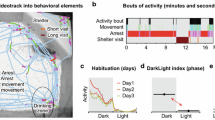Abstract
Recombinant inbred (RI) strains are valuable not only for detecting major gene segregation and linkage but also for identifying associations between behavior and quantitative trait loci (QTL) that account for relatively small amounts of variation in behaviors for which strain distribution patterns are not bimodal. When applied to published data on genetic markers and on behavior for BXD RI strains, the RI QTL association approach suggests the presence of QTLs on chromosomes 6 and 12 for open-field activity and on chromosomes 1, 2, and 17 for high-pressure seizure susceptibility. Because the RI QTL approach does not require that the progenitor inbred strains of a particular RI series differ, researchers could focus on the BXD RI series, for which the greatest number of genetic markers are available. Focusing on BXD would capitalize on the cumulative nature of RI research which permits analyses of QTL sources of genetic correlations across studies.
Similar content being viewed by others
References
Bailey, D. W. (1971). Recombinant-inbred strains, an aid to finding identity, linkage, and function of histocompatibility and other genes.Transplantation 11:325–327.
Blizard, D. A., and Bailey, D. W. (1979). Genetic correlation between open-field activity and defecation: Analysis with the CXB recombinant-inbred strains.Behav. Genet. 9:349–357.
Brauer, R. W., Bever, R. W., Lahser, S., Mansfield, W. M., and Sheehan, M. E. (1977). Time, rate, and temperature factors in the onset of high-pressure convulsions.J. Appl. Physiol. 43:173–182.
Carlson, G. A., Taylor, B. A., Marshall, S. T., and Greenberg, A. H. (1984). A genetic analysis of natural resistance to nonsyngenic cells: The role of H-2.Immunogenetics 20:287–300.
Crabbe, J. C., Kosobud, A., Young, E. R., and Janowsky, J. S. (1983). Polygenic and single-gene determination of responses to ethanol in BXD/Ty recombinant inbred mouse strains.Neurobehav. Toxicol. and Teratol. 5:181–187.
Davisson, M. T., and Roderick, T. H. (1989). Linkage map. In Lyon, M. F., and Searle, A. G. (eds.),Genetic Variants and Strains of the Laboratory Mouse, 2nd ed., Oxford University Press, Oxford, pp. 416–427.
DeFries, J. C. (1969). Pleiotropic effects of albinism on open field behaviour in mice.Nature 221:65–66.
Edwards, M. D., Stuber, C. W., and Wendel, J. F. (1987). Molecular-marker-facilitated investigations of quantitative-trait loci in maize. I. Numbers, genomic distribution and types of gene action.Genetics 116:113–125.
Gelderman, H. (1975). Investigations on inheritance of quantitative characters in animals by gene markers. I. Methods.Theoret. Appl. Genet. 46:319–330.
Gelman, R., Watson, A., Bronson, R., and Yunis, E. (1988). Murine chromosomal regions correlated with longevity.Genetics 118:693–704.
Klein, T. W. (1978). Analysis of major gene effects using recombinant inbred strains and related congenic lines.Behav. Genet. 8:261–268.
Lander, E. S., and Botstein, D. (1989). Mapping Mendelian factors underlying quantitative traits using RFLP linkage maps.Genetics 121:185–199.
Mather, K. (1941). Variation and selection of polygenic characters.J. Genet. 11:159–193.
McCall, R. D., and Frierson, D., Jr. (1981). Evidence that two loci predominantly determine the difference in susceptibility to the high pressure neurologic syndrome type I seizure in mice.Genetics 99:285–307.
McClearn, G. E., Plomin, R., Gora-Maslak, G., and Crabbe, J. C. (in press). The gene chase in alcohol research.Psychological Science.
Neumann, P. E., and Seyfried, T. N. (1990). Mapping of two genes that influence susceptibility to audiogenic seizures in crosses of C57BL/6J and DBA/2J mice.Behav. Genet. 20:307–323.
Oliverio, A. (1979). Uses of recombinant inbred lines. In Thompson, J. N., and Thoday, J. M. (eds.),Quantitative Genetic Variation, Academic Press, New York, pp. 197–218.
Paterson, A. H., Lander, E. S., Hewitt, J. D., Peterson, S., Lincoln, S. E., and Tanksley, S. D. (1988). Resolution of quantitative traits into Mendelian factors by using a complete linkage map of restriction fragment length polymorphisms.Nature 335:721–726.
Plomin, R. (1990). The role of inheritance in behavior.Science 248:183–188.
Sax, K. (1923). The association of size differences with seed-coat pattern and pigmentation inPhaseolus vulgaris.Genetics 8:552–560.
Seyfried, T. N., and Glaser, G. H. (1981). Genetic linkage between the Ah locus and a major gene that inhibits susceptibility to audiogenic seizures in mice.Genetics 99:117–126.
Seyfried, T. N., Glasert, G. H., and Yu, R. K. (1978). Cerebral, cerebellar and brainstem gangliosides in mice susceptible to audiogenic seizures.J. Neurochem. 31:21–27.
Seyfried, T. N., Yu, R., and Glaser, G. H. (1980). Genetic analysis of audiogenic seizure susceptibility in C56BL/6JxDBA/2J recombinant inbred strains of mice.Genetics 94:701–718.
Stout, J. T., McClearn, G. E., Gora-Maslak, G., and Plomin R. (1990). Quantitative trait loci and immunologic functioning: Use of recombinant inbred strains (submitted for publication).
Tanksley, S. D., Medina-Filho, H., and Rick, C. M. (1982). Use of naturally-occurring enzyme variation to detect and map genes controlling quantitative traits in interspecific backcross of tomato.Heredity 49:11–25.
Taylor, B. A. (1976). Development of recombinant inbred lines of mice.Behav. Genet. 6:118 (abstr.).
Taylor, B. A. (1989). Recombinant inbred strains. In Lyon, M. F., and Searle, A. G. (eds.),Genetic Variants and Strains of the Laboratory Mouse, 2nd ed., Oxford University Press, Oxford, pp. 773–789.
Thoday, J. M. (1961). Location of polygenes.Nature 191:368–370.
Thompson, J. N., Jr., and Thoday, J. M. (1979) (Eds.).Quantitative Genetic Variation, Academic Press, New York.
Traina-Dorge, V. L., Carr, J. K., Bailey-Wilson, J. E., Elston, R. C., Taylor, B. A., and Cohen, J. C. (1985). Cellular genes in the mouse regulatein trans the expression of endogenous mouse mammary tumor viruses.Genetics 11:597–615.
Author information
Authors and Affiliations
Additional information
Support for our ongoing research on the RI QTL approach to alcohol-related behavior is provided by NIAAA Grant AA-8125 and the Hanley Foundation.
Rights and permissions
About this article
Cite this article
Plomin, R., McClearn, G.E., Gora-Maslak, G. et al. Use of recombinant inbred strains to detect quantitative trait loci associated with behavior. Behav Genet 21, 99–116 (1991). https://doi.org/10.1007/BF01066330
Received:
Accepted:
Issue Date:
DOI: https://doi.org/10.1007/BF01066330




